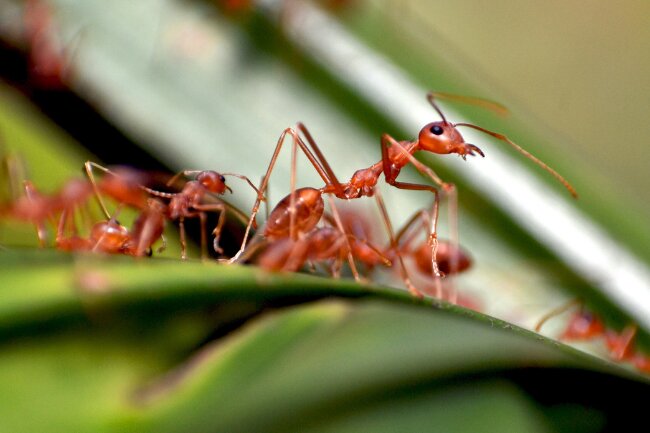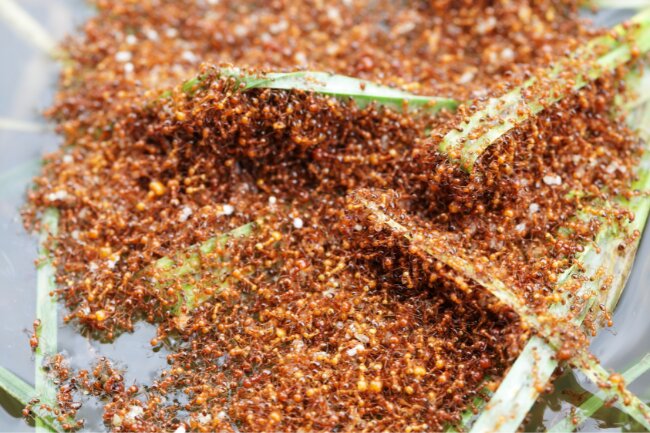Ant colony size can vary massively depending on species, time of year, age of colony, and other factors. In general, colonies number between a few hundred to a few thousand individuals. Some ant species also form super colonies that can be composed of billions of ants.
Contents
What is an ant colony?

Ants are eusocial insects, this means they are cooperative, having traits like shared brood care. There are around 12,000 species of ants across the world, and all of these live their lives as a group within a colony.
The colony is composed of the many individual ants that carry out a variety of tasks to ensure the colony as a whole functions. The head of the colony is a queen. She emerges from her mother’s colony and undertakes a nuptial flight, where she mates with a male (drone).
Having mated, she sets up her own colony, digging a nest and beginning to produce young. The majority of her young are workers, who are female. In some colonies, there are subtypes of workers who have different morphological characteristics, and carry out different tasks.
Once the queen has enough workers to take care of her, she no longer leaves the nest, and is cared for by the workers. The other castes of ants are the sexual generations in the form of young queens and drones. The queen produces these are certain times of years, and in most species they do not remain long in the nest, leaving to mate and set up new colonies.
Within the colony workers will carry out a wide range of tasks, from caring for the young and the queen, building tunnels, searching for food and even removing the dead.
For most species, the colony is sheltered in a physical structure, such as a nest. This can be a based within the soil, within leaf litter or under rocks or rotten wood. Some species do not have a physical nest, such as army ants. Army ants tend to create bivouacs, which are structures they create by joining their bodies together.
Also read: Wondering “How do Ants Reproduce & If They Lay Eggs”?
How big is an ant colony?

Ant colony size varies massively, depending on a number of other factors.
| Factor | Impact on Colony Size |
|---|---|
| Species Characteristics | Different species have varying colony sizes. Some species have smaller colonies, while others have larger colonies. |
| Available Resources | Abundance of food, nesting sites, and favorable conditions can support larger colony sizes. |
| Environmental Factors | Climate, temperature, and other environmental factors can influence the size of ant colonies. |
| Colony Age | Older colonies tend to have larger populations compared to newly established colonies. |
Age
Age is an important factor for a colony size. Although ant queens can give birth to large numbers of young, it still takes time to build up the numbers of adults within a colony. Younger colonies are therefore generally smaller.
Season
Within temperate zones, winter is a tough time for ants. Ant species do not migrate, and they also don’t die out in the winter. Instead, they tend to hunker down within their nest and wait out the bad weather.
During this time, they may be surviving off stored food and keeping warming by huddling together. However, these tough conditions do result in a slow decrease in the number of ants in the colony.
Species
The 12,000 ant species across the world can live in very different conditions, and be adapted to very different lifestyles. Therefore, the numbers of ants within a colony can vary, depending on the species.
Also read: “Do Ants Migrate?” How do They Survive Winter?
How many ants are in a colony?

In general, an ant colony will have between a few hundred and several thousand individuals. Even within species, these numbers can vary massively due to other factors or local conditions.
In terms of particular species numbers, the average numbers of different species can vary massively. Formica yessensis is known to have very large colonies, sometimes with up to 300 million individuals. Yellow meadow ants, by comparison, have around 5,000 individuals.
Another species with large colonies is Fire ants, which can have between 100,000 to 500,000 individuals. Bullet ants, one of the largest ant species in the world, have a relatively small nest, with a few hundred individuals.
| Ant Species | Average Colony Size |
|---|---|
| Argentine Ant (Linepithema humile) | 10,000 – 300,000 ants |
| Carpenter Ant (Camponotus spp.) | 3,000 – 10,000 ants |
| Fire Ant (Solenopsis invicta) | 100,000 – 500,000 ants |
| Harvester Ant (Pogonomyrmex spp.) | 3,000 – 10,000 ants |
| Leafcutter Ant (Atta spp.) | 1,000,000 – 8,000,000 ants |
Super colonies
A small number of ant species form something known as super colonies. This is where related colonies will cooperate. This is very unusual as in most ant species, ants will be aggressive towards ants from other colonies, even if their queens are related.
The most famous example of this is Argentine ants, which have been found to be extremely cooperative, even to ants from non-related colonies, so long as they are of the same species. One super colony in Europe has been found to be 6,000km long and composed of 30 colonies.
| Insect Species | Average Colony Size |
|---|---|
| Ants | Varies greatly among species, ranging from a few hundred to millions of individuals |
| Bees | A few hundred to tens of thousands of individuals |
| Termites | Several hundred to several million individuals |
Also read: How do Ants Communicate? (Different Ways & Situations)
Living it large
When it comes to ant colony size, bigger isn’t always better. Depending on the local conditions, it may be more sustainable for the colony to be smaller. For example, in areas where there is little food availability, a bigger colony may endanger the ants by not allowing for enough resources to sustain it.
However, where there is more food there may also be more predators, so larger numbers will mean predation can be sustainable, without the colony completely collapsing. While ant colony size may seem random to us as outsiders, it is a reaction to many different factors surrounding the colony. In the end, big or small, the ants will choose the optimum size to help them survive.

